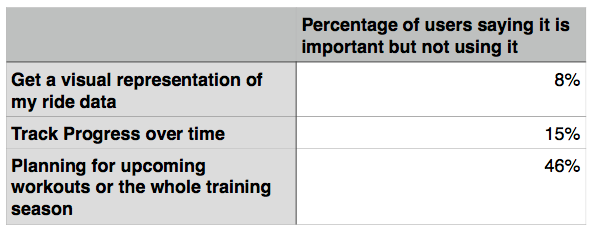The Planning Conundrum
Editorial Note: This article was originally published on 2017-03-22 on Medium and is still available there at the time of writing. I re-publish it here for two reasons: First, I want to have it under my own control. And two, as much as it pains me to say, it is still relevant. This is part three of a series of three. Here are parts one - The Cycling Software Market is Highly Fragmented, and two - Helping Athletes see a Bigger Picture. I have also added a commentary that tries to add some perspective. I’d like to thank Eric DeGolier from Body Rocket for unearthing these articles and helping me re-discover some personal ancient history.
The original article:
Around New Year 2017 we created an online survey to get a better understanding of how users incorporate software into their everyday training. Specifically, which software (or combination of software tools) they use, and why. The ultimate goal is to help the development of a new user experience for the Open Source training software GoldenCheetah, but we hope that the results are found to be helpful beyond this scope. You can download the report at the bottom of the page if you’re looking for results and a bit more context. In a series of articles, I want to reflect on the findings, and explore new insights. You can read part 1 here and part 2 here.
In this article, I want to talk about planning upcoming workouts or events, and how people use such features. One could argue that long-term thinking and planning ahead is the most important thing an endurance athlete could do (except for training itself), and I’ve touched this issue briefly before.

But wether athletes are planning ahead or not, they are not using software to do that. Only 33% resp. 44% of recreational riders and (self)coached athletes are using any planning features their software provides.
And here comes the interesting part:

Planning ahead is hard, and roughly half of all users who think it is important don’t feel supported by the software tools they use. Either because the software flat-out doesn’t support it, or it is designed in a way that it is not helping these athletes.
Designing better planning facilities
When it comes to designing better planning facilities, two aspects are most important: Predictive power and adaptability.
Predictive power
Plans are always outcome-oriented. A training plan must be able to predict top form for the possibility of top performance on a designated date.
This means the plan must balance training load in a way that leads to optimal form (optimal tradeoff between freshness and fitness) on a given date or a series of dates.
But it also must include such types of workouts that optimally adapt the body to the demands of the event the athlete is training for.
Training for a 30 minute Time Trial will significantly differ in structure from a training program for a one hour crit. To correctly predict peak performance, the training plan must be able to predict the right workouts for the plan.
Adaptability
How should my training plan adapt if I don’t do the prescribed workouts, but something else?
This is an often overlooked aspect of the training of non-professionals. As much as we love our sport, and as much as we are willing to sacrifice to it, sometimes you will miss workouts because of work or family duties.
And if you think about it, people do unplanned workouts all the time. They go hard on a group ride when they should go easy. They have fun on their bikes when the should follow their training plan (how dare they!). They are too tired for their intervals and go for an easy ride. It’s not just about missed workouts, it’s also about doing something else to what your training plan says.
Software must be able to accommodate these changes and adapt the plan accordingly, or warn that such an adaption is not possible if the deviation is too big. It should also warn you when you’re training different capabilities than the ones you need for your target events.
If the resulting plan is flexible enough to allow for some deviation in it, athletes might find it easier to follow it in principle.
Predictive power and adaptability are two key elements for every software service that wants to cater to the 47% of athletes who recognize the importance of planning, but currently don’t plan (with the help of software).
If a software tool is able to balance training load management with time available for workouts, can choose workout types that will yield the best results in regards of the athletes goals, and adapt to variations in actual training, it would very likely be of benefit for a substantial number of athletes.
And if it could learn which types of workouts have a higher probability of completion (because the athlete enjoys them), and adapts the plan accordingly, such plans would no longer be considered obtrusive and restraining, removing one of the often heard sentiments against training plans by athletes.
Can a software algorithm successfully coach an athlete with average goals and enough discipline to follow a simple training plan? I don’t know. But if it can, the internet coaching business is in for a rough ride.